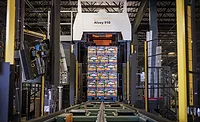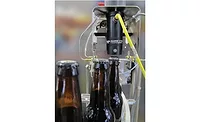Palletizers adapt to product evolutions
Advancements stay in step with SKU proliferation
Bulk, portion-control, lightweight, flexible and additional packaging innovations have placed a strain on production equipment such as palletizers. To adapt to the ever-expanding list of package options, conventional, hybrid and robotic palletizers as well as complementary technology have been developed that can adjust to the various demands of a production facility. Whether SKU proliferation is spurring requests for quick changeovers, lower speeds, variety packs or mixed pallet loads, equipment manufacturers are heeding the call.
Quick changeover times are a must for operations that are accommodating more package sizes, types and flavors, says Ted Yeigh, sales director for Columbia Machine Inc., Vancouver, Wash. He notes that SKU proliferation often is compounded by the desire to conduct shorter production runs and stock lower amounts in inventory.
One of Columbia’s standard components for quick changeovers is its Product Manager software, which stores as many as 300 pre-loaded patterns in its human-machine interface (HMI), Yeigh says. In addition, the company offers centering side retainers as well as motorized backstops, which ensure that loads of various sizes are centered on pallets on both axes, he adds.
Columbia also is seeing customers running smaller package sizes and designs with higher centers of gravity. In response, the company has the option of variable frequency drives and close-centered rollers on its palletizers, Yeigh says.
“However, since we are seeing more of these small case applications, many of the necessary inclusions to handle small cases, such as four-sided layer containment, have become standard features on many of Columbia’s palletizers,” he explains.
Sidel has a full portfolio of palletizing, depalletizing, pallet handling, casing and uncasing solutions, including traditional machines, single-column technology and robotic solutions, explains Mike Decotiis, Montreal-based director of business development and marketing for engineering and material handling at Sidel. Most recently, the company developed its high-speed low-level in-feed palletizer with a two-column design. The model is capable of reaching speeds that were previously available with its high-level in-feed configuration, Decotiis says.
Customized orders
Sidel also offers the Robo-Smart and Axo-Smart modular layer-formulation systems for palletization. The Robo-Smart layer preparation device uses a Fanuc robot for continuous and positive pack handling, Decotiis explains. The Axo-Smart device is based on a gantry configuration for a cost-effective plug-and-play device that is able to handle heavier packages than the Robo-Smart solution, he notes. These layer-forming devices are usually coupled with Sidel’s user-friendly PLACE software that allows for immediate on-site modification or creation of new pallet patterns, Decotiis adds.
Distribution customers are looking for solutions that build store-friendly and aisle-ready pallets, which more frequently are including non-beverage items, explains Sean O’Farrell, market development director for Dematic Corp., Lisle, Ill.
“I’m seeing some of these beverage companies wanting to carry other products like snacks or food products to complement what they’re offering [as well as] trying to grow their revenue and their profits, and increase satisfaction with their customers,” O’Farrell says.
To help accommodate these mixed loads, O’Farrell foresees the transition to more rolling containers or carts that can easily be transported to retail accounts.
In addition to its Ergo-Pal and manual palletizers, Dematic offers the Multishuttle, a high-density storage and retrieval system that is SKU-independent and helps to stage, sort and sequence loads, he explains. To indicate the ideal placement of the product on the pallet, the company also offers a software module that assesses SKUs based on 16 attributes, including crushability as well as where a product might be located in a store.
Best of both worlds
Combining elements of traditional and innovative palletization options, companies have created hybrid and semi-automatic systems that offer advancements as well as ease of use. Last year, Columbia Machine introduced the R-Factor Hybrid Floor Level Palletizer. The model combines a Motoman articulated robotic arm with a conventional palletizer that is controlled through Rockwell Automation’s ControlLogix PLC with Agile Planet’s RLX technology. The R-Factor is able to handle delicate products, those with high centers of gravity and label-out products. In addition, it can stand up hard-to-handle product prior to layer formation, according to the company.
The Alvey 950 Series Hybrid Palletizer from Intelligrated blends conventional palletizing with robotic product handling, explains Earl Wohlrab, palletizing and robotics systems product manager for the Mason, Ohio-based company. The hybrid machine offers adaptability for a range of products, secondary packaging, patterns and sizes through the drag-and-drop pattern creation on the 950’s HMI system, according to the company. The Alvey 950 Series is capable of speeds as fast as 125 cases a minute depending on the product and pattern, Intelligrated says.
An additional semi-automatic system is the Model 72SA from A-B-C Packaging Machine Corp., Tarpon Springs, Fla. The case palletizer lifts cases and stacks products on a pallet while an operator manually positions cases into the pallet pattern by sliding the products from the in-feed conveyor onto the loading table, the company says. Once a pallet layer is complete, the operator activates the machine and the layer is automatically lifted and placed on top of the previous layer, it adds. To center the layer on the pallet, the Model 72SA uses a rear-layer retainer plate and two side-layer squaring plates.
Adapting innovations
In addition to the Alvey 950 Series, Intelligrated has a complete line of conventional, hybrid and robotic palletizing options. For distributors that are creating rainbow pallets with alternating full layers of products, Intelligrated’s conventional or robotic solutions are applicable, Wohlrab says. If a customer is looking for retail-ready pallets of items organized by customer or order, he recommends a wholly robotic solution that would feature a particular piece of tooling and specific software that would apply to a mixed case order.
Hartness International has seen demand for its robotic palletizers slow down from product manufacturers, but pick up for applications requiring variety pack configuration as well as warehouse and distribution installations, explains Matt Job, head of the robotics group for the Greenville, S.C.-based company. The company has begun developing solutions to accommodate the rise in variety pack offerings, which combine two to four flavors into standard secondary sizes of 18- or 24-packs.
“With robotics, it really makes it simple to go from one flavor to the next flavor and all these different configurations with, not no cost, but with minimal cost to try different products, get them to market quicker, and then really test out and validate if that’s really where the market is going,” Job says.
Job notes that Hartness is focusing its robotics research and development on new innovations for variety pack lines because that’s where its customers are indicating their focus will be in the coming years. Variety pack production does not require high-speed packaging lines, he notes. Instead, customers are choosing lines that operate at 20 cases a minute at a higher overall equipment effectiveness rate than lines that carry 70 cases a minute, Job explains. He attributes the request for lower speeds to the fact that re-packaging lines require more variables.
In addition, the company has seen recent requests to accommodate new staggered or off-set packages of bottled water. Hartness reconfigured its standard high-speed beverage palletizing system to handle both current packages as well as the newly popular nested packs, Job says.
Innovations and trends in packaging will continue to have their effects on production equipment, suppliers say. Columbia’s Yeigh notes that the expansion of flexible packaging might reduce demands on depalletizers, but will pose challenges for some palletizer applications. Also affecting depalletizers, Sidel’s Decotiis notes that the embrace of in-house plastic bottle manufacturing will likely lessen demand for depalletizers for plastic packaging; however, aluminum and glass will still require depalletization equipment that is fast, robust and reliable. BI
Looking for a reprint of this article?
From high-res PDFs to custom plaques, order your copy today!






